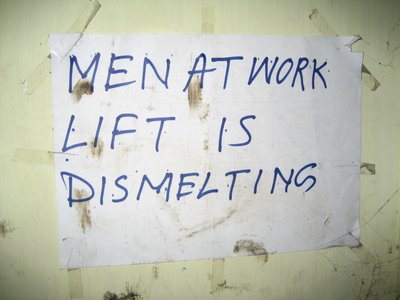 It may be said that Mumbai is the (Indian) city of dreams, a place where an ambitious businessman can achieve incredible wealth, and a budding thespian can give concrete shape to their celluloid dreams.
It may be said that Mumbai is the (Indian) city of dreams, a place where an ambitious businessman can achieve incredible wealth, and a budding thespian can give concrete shape to their celluloid dreams.
Passing a week there illustrated to me why the mega-metropolis is a destination for dreamers – posh colonies with chic boutiques and swanky lounges serve up international brands to the high-heeled glitterati.
It is, however, a city of extreme and undeniable contrasts. Although it has the largest concentration of wealth in India, it is home to the single largest slum in Asia with nearly a million occupants. This slum, and others that sprawl in a similar fashion, provide ample setting for even the smallest of dreams to die a cruel merciless death.
Although I may soon end up there, I don’t dream of Mumbai.
Taking full advantage of my window seat, some 5,000 feet above the city, I look down on Mumbai's amorphous sea of lights and think wistfully of Kolkata. I squint and imagine those lights displaced by the rush of the Hooghly and not uninterrupted as they now appear. But in that case I would be looking down on Kolkata and leaving it, so perhaps that would leave me no better.
 Before I left for India, something about Kolkata (Calcutta) called to me. Considering it was the closest “urban” – a word that is so wonderfully subjective here – area to my work in Ranchi, I could think of no better spot for my first mini-vacation. I did not leave disappointed.
Before I left for India, something about Kolkata (Calcutta) called to me. Considering it was the closest “urban” – a word that is so wonderfully subjective here – area to my work in Ranchi, I could think of no better spot for my first mini-vacation. I did not leave disappointed.
As soon as I boarded the train in Ranchi, I could feel it.
I knew it from the moment my ears were graced with the sweet melodic sound of Bengali.
From my first glimpse of the Bengali script, a touch more angular than its cousin, Hindi, numerous triangles festooned with innumerable swirls.
From arriving at Howrah rail station and journeying across Howrah bridge: the stunning thickness of the smog-laden evening air dwarfed only by the viscosity of the traffic below it (on the world’s busiest bridge).
From zigzagging my way across the Hooghly River (an offshoot of the mighty Ganga) aboard ferries, gazing at colorful crowds of locals on the banks performing puja (praying), bathing, swimming, and “wastewatering”.
 From witnessing various touching father-son moments, fathers shamelessly holding mini-penises, their sons letting fly into the street.
From witnessing various touching father-son moments, fathers shamelessly holding mini-penises, their sons letting fly into the street.
From wandering the streets of North Kolkata and being reminded of Havana (with less ass-shaking and –peddling), bougainvilleas spilling on to the streets from formerly well-apportioned balconies.
From stumbling upon the Pareshnath Jain temple and its intricate mosaics of mirrors, tiles, gold inlays, and paintings, seamlessly and peacefully tucked into a North Kolkatan side street.
From the various relics of the British Raj: the Maidan, a common in the center of the city where I finally had a chance to re-polish my Guatemalan football skills; the Victoria Memorial, possibly the finest piece of architecture left by the Brits on the subcontinent; and the Park St. Cemetery, in whose therapeutic shade I took refuge from the madness of Kolkatan streets.
From the absolutely sublime fish curries. And the addling addictiveness of the hot kati roll, a curry-laced, blazing hot fajita.
From the Girish Park metro station, in which a pair of 8-year old boys and I provided ample entertainment for everyone around, making faces at each other, and exclaiming wildly in English, Hindi, Spanish and Bengali.
 From the evening of Kali Puja, when we jam-packed ourselves into a truck with the blue goddess Kali, maneuvered our way via the equally jammed (and raucous) streets down to the river and tossed her in.
From the evening of Kali Puja, when we jam-packed ourselves into a truck with the blue goddess Kali, maneuvered our way via the equally jammed (and raucous) streets down to the river and tossed her in.
From reacquainting myself with the traveler’s lifestyle as well as conversations borne from moments with fellow travelers, especially Jonny & Lucy. L let me borrow J for backgammon and J let me borrow L for dancing.
From my various clubbing excursions (Tantra, Venom & Roxy), in which I was photographed and put on page 3 of The Times of India (either due to my noticeable dancing skills or my noticeable size and complexion).
(NB: I think the other time I died in India was on a motorcycle. Remind me not to do that again. Thanks.)
 I knew it then and I know it now, yet I’m not quite sure what it is that I know. I fell in love with something but was it Kolkata, or was it being on vacation, or was it my reintroduction to traveling?
I knew it then and I know it now, yet I’m not quite sure what it is that I know. I fell in love with something but was it Kolkata, or was it being on vacation, or was it my reintroduction to traveling?
Upon his return from Calcutta, Mark Twain said, "I'm glad I went, and I'm glad I never have to go back."
When I returned I said, "I'm glad I went. Why did I ever leave?"
I guess not everyone is into fish curries.
.jpg)
.jpg)
















